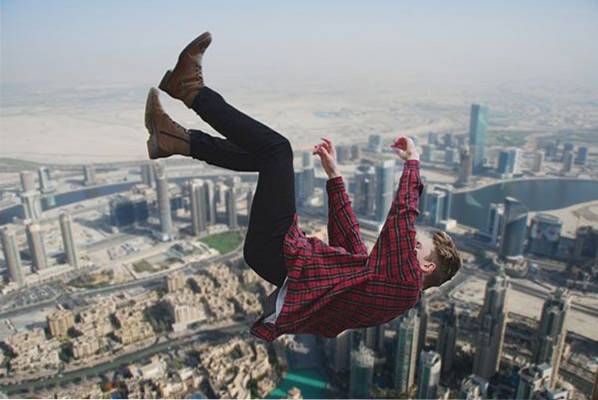
Acrophobia the irrational fear of heights

Acrophobia is an extreme and irrational fear of heights and belongs to a category of specific phobias. Unlike other phobia such as aerophobia, which only defines the fear of flying, acrophobia encompasses a variety of situations related to being away from the ground. Depending on the severity of the disorder, the subject may fear being on a high floor of a building or simply climbing a ladder.
Contents
- Is vertigo the same as acrophobia?
- Prevalence of acrophobia
- Causes of acrophobia
- Symptoms of acrophobia
- Emotional symptoms
- Physical symptoms
- Anxiety and avoidance response
- Acrophobia and related disorders
- Bathmophobia
- Climacophobia
- Aerophobia
- Treatment of acrophobia
- References
Is vertigo the same as acrophobia?
Immortalized by the 1958 Alfred Hitchcock film of the same name "Vertigo", this term is often misused. Many people mistakenly speak of "vertigo" when they want to refer to fear of heights or even simple dizziness. However, vertigo is a term that specifically describes a false sense of movement..
Thus, vertigo refers to a subjective sensation of movement of the objects that surround us or of our own body. The one that the person who suffers from it feels that he or she is spinning or moving, or that the world is spinning around them, and this sensation can be accompanied by nausea and vomiting. Acrophobia, on the other hand, is something very different from vertigo, although both conditions can coexist. For example, if we are at a great height and look down or up, this can cause dizzying sensations of movement. At the same time, this perception of spin can feed back the fear of heights..
Prevalence of acrophobia
Most people experience some natural fear when exposed to heights, it is the typical feeling of fear of falling. Although there are those who have little or no fear of heights.
People with acrophobia can have a panic attack when they are in high places and desperately trying to descend safely. Approximately 2-5% of the general population suffer from acrophobia, with twice as many women affected as men.
Causes of acrophobia
Until relatively recently, the origin of fear of heights, like many other phobias, was attributed to learning (conditioning) or a traumatic experience. But recent studies have offered another explanation. Apparently the fear of falling, along with the fear of loud noises, is one of the inborn or "non-associative" fears that humans most commonly suffer..
The theory is that the fear of heights is an adaptive evolution to a world in which falls pose a significant danger to personal integrity and health. Researchers have argued that fear of heights is an instinct found in many mammals, including domestic animals and humans..
Experiments conducted using visual techniques have shown that infants and toddlers, as well as other animals of various ages, are reluctant to walk on a glass floor with a view of a few meters of apparent drop below it. While an innate caution toward heights is helpful for survival, extreme fear can interfere with activities of daily living..
In some cases the origin of acrophobia is a dysfunction to maintain balance. In these cases, the anxiety is well founded and the disorder is secondary. The human balance system integrates visual cues to recognize position and movement. As height increases, visual cues recede and balance becomes poorer even in people without problems. However, most manage this sensation using the proprioceptive and vestibular branches of the balance system..

Fear of heights is linked to visual perception.
An acrophobic, however, continues to rely too heavily on visual cues either from inadequate vestibular function or from an incorrect strategy. High altitude locomotion requires more than normal visual processing as the visual cortex becomes overloaded and confused. Some professionals warn that it can be counterproductive to encourage acrophobes to expose themselves to heights without first resolving vestibular issues. Research is ongoing at various clinics.
Symptoms of acrophobia
On both an emotional and physical level, the response to acrophobia is similar to the response to any other phobia. The most frequent signs are:
Emotional symptoms
Feeling of panic when it is perceived that one is in a high place. Instinctively, the subject may begin to search for something to hold on to, discovering that he cannot trust his own sense of balance. The most common reactions include immediately descending, crawling on all fours, and kneeling or basically bending the body..
Physical symptoms
They can appear to shaking, sweating, palpitations, screaming and crying. The person often feels terrified and paralyzed. It may be difficult for you to think.
Anxiety and avoidance response
The person with acrophobia fears being in situations where they have to spend time in high places. For example, you can get very nervous and not want to go to visit natural places with great heights and cliffs, you can panic riding a fairground attraction that rises too high, climbing elevators with glass walls, etc..
The greatest danger that most phobias present is the risk of limiting our life and activities to avoid the dreaded situation. However, acrophobia is a special case, since having a panic attack while at a great height can cause us that fall that we fear so much inside, because panic can lead us to make unsafe movements. Therefore, it is extremely important that acrophobia is professionally treated as quickly as possible, especially if heights are a regular part of our life..
Acrophobia and related disorders
Other disorders that are related to acrophobia and that can occur (apart from vertigo) include:
Bathmophobia
It is the fear of slopes and stairs. People with this disorder may panic at the sight of a steep slope or steep, high stairs, even if they have no need to climb them. Although many people with bathmophobia have acrophobia, most of those with acrophobia do not experience bathmophobia as well..
Climacophobia
This fear refers to the fear of having to go up or down stairs. These people are not afraid of seeing a steep flight of stairs, as in the previous case, as long as they can stay safely at the bottom. Thus, climacophobia can occur at the same time as acrophobia.
Aerophobia
This is the specific fear of flying. Depending on the gravity, the subject may be afraid of airports and airplanes, or may be afraid when in the air. Aerophobia can occasionally occur along with acrophobia.
Treatment of acrophobia
Treatments for acrophobia include:
- Psychotherapy: Cognitive behavioral therapy is the most widely used treatment for all specific phobias. Behavioral techniques of exposure to the feared situation either gradually (systematic desensitization) or rapidly (flooding) are used frequently. In addition, the patient is taught ways to stop the panic reaction and regain emotional control..
- Medication: sedatives or beta blockers can sometimes be prescribed to relieve feelings of panic and anxiety.
- Relaxation: Doing yoga, breathing deeply, meditating, or progressively relaxing your muscles can help you cope with stress and anxiety. Regular exercise is also quite effective.
References
http://www.wadsworth.com/psychology_d/templates/student_resources/0155060678_rathus/ps/ps05.html
https://www.ncbi.nlm.nih.gov/pmc/articles/PMC5345832/
https://www.ncbi.nlm.nih.gov/pmc/articles/PMC4081005/



Yet No Comments